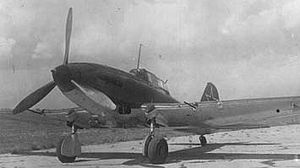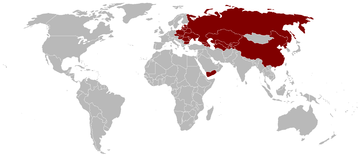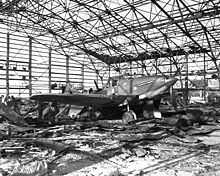Ilyushin Il-10 Videos and Pictures

|
|
Ilyushin Il-10
Il-10

Role: Ground attack aircraft
Manufacturer: Ilyushin, Avia
First flight: 18 April 1944
Introduced: 1944
Retired: 1962 (Czechoslovakia)
Primaryusers: Soviet Air Force
Czechoslovak Air Force
Polish Air Force
Produced: 1944-1954
Number built: 6,166 (4,966 Il-10 + 1,200 B-33)
Developed from: Ilyushin Il-2
Ilyushin Il-10 (Cyrillic Ил-10, NATO reporting name: "Beast") was a Soviet ground attack aircraft developed at the end of World War II by the Ilyushin construction bureau. It was also license-built in Czechoslovakia by Avia as the Avia B-33.
Development
From the start of Eastern Front combat in World War II, the Soviet Air Force (VVS) used the successful ground attack aircraft Ilyushin Il-2 Shturmovik, powered by the Mikulin AM-38 inline engine (aviation). As the war progressed, the Soviets laid plans for its successor. The main goal was to increase speed and maneuverability at low altitudes, mainly to evade small-caliber anti-aircraft artillery, which was the main danger for ground attack aircraft, and to remove some other Il-2 faults. The most promising project was a modern light and maneuverable close assault aircraft, Sukhoi Su-6, developed by Pavel Sukhoi's bureau from 1942. At the same time, Sergei Ilyushin developed a heavier aircraft, the VSh or Il-8 M-71, derived from the Il-2 design, and on which it partly based. Both projects were powered by the prototype M-71 radial engine, which was not produced.
In 1943, Ilyushin started work on a new aircraft, Il-1, which was to be a 1- or 2-seat heavy armoured fighter-interceptor, meant mainly for fighting enemy bombers and transports. The Il-1 was similar to the Il-2 design, but was more modern and compact, and powered with a new Mikulin engine, the AM-42. But the air force gave up the idea of heavy armoured fighters, due to their low speed, which was not enough to intercept modern bombers. As a result, Ilyushin decided to turn the Il-1 into a two-seat ground attack plane, with the designation changed to Il-10 in early 1944 (odd numbers were reserved for fighters).
At that time, Ilyushin also finished a prototype of a heavier ground attack plane, the Il-8, with the same engine, more closely derived from the Il-2 design. It carried more payload (1,000kg/2,204lb), but had lower performance than the Il-10. Both types first flew in April 1944, the Il-10 proving greatly superior to the Il-8, which had poor handling. The Il-10 successfully passed state trials in early June 1944.
The third competitor was a new variant of the Sukhoi Su-6, also powered by the AM-42 engine. After comparative tests, the Il-10 was considered the winner and was chosen as the new ground attack plane, despite some opinions that the Su-6 was a better aircraft, with inferior performance and payload, but better gun armament. Notably, the Su-6 prototype was tested with maximum payload, causing lowered performance, while the Il-10 was tested with normal payload. Some advantages of the Il-10 were from its technical similarity to the Il-2.
Production
Picture - Avia B33 in the Polish Aviation Museum
On 23 August 1944 the Il-10 was ordered into serial production by decision of the State Defense Committee (GKO), as a new ground attack plane. Its armament was initially similar to late model Il-2s, with two 23mm VYa-23 cannons and two ShKAS machine guns in the wings, and a 12.7mm UBT machine gun for a rear gunner, and 400kg, or a maximum 600kg of bombs. Unlike the Il-2 and Su-6, initially it was meant to carry no rockets.
Production of the Il-10 started in factories No. 1 and No. 18 in Kuybyshev. The first serial plane flew on 27 September 1944 and 99 aircraft were produced by the end of 1944. Early series planes showed teething problems, most notably engine faults and fires. Most problems were eliminated in 1945. Aircraft produced from April 1945 could carry four unguided air-to ground rockets. Aircraft produced from 1947 were fitted with stronger armament, of four 23mm NS-23 cannons in wings and a 20mm cannon for a rear gunner. Il-10 production ended in 1949, after making 4,600 aircraft; in the last two years, they were produced in factory No. 64.
In 1945-47, 280 UIl-2 or Il-10U trainer variants were produced. The rear gunner cab was replaced with a longer instructor cab, with dual controls. Its performance and construction were similar to the combat variant, apart from armament, which was reduced to two cannons, two rockets, and a standard load of bombs.
In 1951, the Czechoslovak works Avia secured a license to make Il-10s, with the designation B-33. The first one flew on 26 December 1951. Initially, their engines were Soviet-built. From 1952, the engines were also made in Czechoslovakia as the M-42. Besides the combat variant, a trainer variant was made, with designation CB-33. In total, 1,200 B-33s were made by 1956.
In 1951, due to the Korean War experience, the Soviet Air Force decided that propeller ground attack aircraft might still be useful, and decided to renew Il-10 production in a modified variant Il-10M. It first flew on 2 July 1951. It was a bit longer, with a longer wingspan, and bigger control surfaces, with a fin under the tail. Four newer cannons, NR-23, were mounted in the wings, the payload stayed the same, and newer navigation equipment was installed, giving some all-weather capability. Its speed decreased slightly, but handling improved. In 1953-54, 146 Il-10Ms were made, all but 10 in factory No. 168 in Rostov-on-Don.
In total, 6,166 of all Il-10 variants were made, including those built under license.
Trials occurred of Il-10s with stronger AM-43 and AM-45 engines, but were unsuccessful. Ilyushin next designed a lighter close-assault plane Il-16, with improved performance and similar armament. It first flew on 10 June 1945. Production of a small series began, but the works were cancelled in 1946 due to AM-43 engine unreliability.
Design
Technical description
The airframe featured one engine, two-seat, monoplane, with a metal-covered frame. The plane was highly armoured. The front part of the fuselage, with the cockpit, was a shell of armour plates 4-8mm thick; the thickest, 8mm, were under the engine, there was no armour above the engine. The front windshield was made of armour glass 64mm (2.5in) thick. Also armoured was: a roof above the pilot, side window frames in the pilot's cab, a wall between crew seats, and a rear wall behind the cab. Total armour weight was 994kg, including its attachment. The wing consisted of a central section, with two bomb bays, and two detachable outer panels. The undercarriage was retractable. The main wheels folded to the rear after rotating by 86°.
Early Il-10s had two 23mm VYa-23 autocannons (150 rounds each) and 2 7.62mm ShKAS machine guns (750 rounds each) fixed in wings, and a 12.7mm UBT machine gun in a rear gunner station BU-8, with 150 rounds. The horizontal angle of the rear machine gun field of fire was 100°. From 1947, the aircraft were armed with four NS-23 23mm cannons in the wings (150 rounds each) and 20mm B-20T cannon in a rear gunner station BU-9 (150 rounds). The IL-10M had four 23mm NR-23 cannons in wings (150 rounds each) and 20mm B-20EN cannon in a rear gunner station BU-9M (150 rounds). Avia B-33 had four 23mm NS-23RM cannons in wings and 20mm B-20ET cannon in a rear gunner station BU-9M.
The normal bomb load was 400kg, maximum load was 600kg. This could be small fragmentation or anti-tank bomblets, put in bomb bays, or four 50-100kg bombs in bomb bays and externally under wings, or two 200-250kg bombs attached under wings. Small bomblets were put directly on bomb bay floors, in piles. A typical load was 182 (maximum 200) 2kg AO-2,5-2 fragmentation bombs, or 144 PTAB-2,5-1,5 anti-tnk HEAT bombs. Apart from bombs, four unguided rockets RS-82 or RS-132 could be carried on rail launchers under wings. Avia B-33s were also fitted to carry other rocket types. Late Soviet aircraft could carry ORO-82 and ORO-132 tube launchers. In the tail section was a DAG-10 launcher with 10 anti-aircraft or anti-personnel grenades AG-2 (after being thrown, they would fall with parachutes and then burst, but were not widely used in practice).
The Il-10 engine was a 12 cylinder inline V engine Mikulin AM-42, liquid cooled, power: 1,770hp continuous, takeoff power: 2,000hp. Three-blade propeller AV-5L-24 of 3.6m diameter. Two fuel tanks in the fuselage: upper 440l over engine, ahead of the cockpit, and lower tank of 290l under the cockpit. The aircraft had a radio set and a camera AFA-1M in a rear section of the fuselage.
Operational history
In October 1944, the Il-10 first entered service with training units in the Soviet Air Force. In January 1945, the first Il-10 combat unit entered service with the 78th Guards Assault Aviation Regiment, but it did not enter action due to unfinished training. However, three other Il-10 units managed to take part in the final combat actions of World War II in Europe. They were the 571st Assault Aviation Regiment (from 15 April 1945), the 108th Guards Assault Aviation Regiment (from 16 April 1945), and the 118th Guards Assault Aviation Regiment (on 8 May 1945). About a dozen aircraft were destroyed by flak or engine breakdowns, but the Il-10 appeared to be a successful design. One was shot down by an Fw 190 fighter, but a crew of the 118th Regiment shot down another Fw 190 and probably damaged another. On 10 May 1945, the day after the official Soviet end of the war, (Victory Day), there were 120 serviceable Il-10s in Soviet Air Force combat units, and 26 disabled ones.
After the USSR reentered the war against Japan, with the invasion of Manchuria, from 9 August 1945, one Il-10 unit, the 26th Assault Aviation Regiment of the Pacific Navy Aviation, was used in combat in the Korean Peninsula, attacking Japanese ships in Rasin and rail transports.
After the war, until the early 1950s, the Il-10 was a basic Soviet ground attack aircraft. It was withdrawn from service in 1956. At the same time, work on new jet-powered dedicated armoured ground attack planes (like the Il-40) was canceled, and the Soviets turned to multipurpose fighter-bomber aviation. The Il-10 and its licensed variant, the Avia B-33, became a basic ground attack plane of the Warsaw Pact countries. From 1949 to 1959, the Polish Air Force used 120 Il-10s (including 24 UIl-10), and 281 B-33s. In Poland, the B-33 was modified to carry 400l fuel tanks under its wings. From 1950-60, Czechoslovakia used 86 Il-10s, including six UIl-10s, and about 600 B-33s. From 1949-56, the Hungarian Air Force used 159 Il-10s and B-33s. From 1953-60, the Romanian Air Force used 30 Il-10s and 150 B-33s. Bulgaria also used these aircraft.
In the late 1940s, 93 Il-10 and UIl-10s were given to North Korea. They were then used in the 57th Assault Aviation Regiment during the early phase of the Korean War. They were initially used with success against the weak anti-aircraft defense of South Korean forces, but then they suffered heavy losses in encounters against the US fighters and were bombed on the ground themselves. After several weeks, about 20 remained. In the summer of 1950, North Korea received more aircraft from the USSR. The North Koreans claimed to sink a warship on 22 August 1950 with Il-10s, but it was never confirmed.
From 1950, Il-10s were used by the People's Republic of China, in two regiments of an assault aviation division. They were used in combat during a conflict with the Republic of China, (Taiwan), over border islands in January 1955. They remained in service until 1972. From 1957, Yemen used 24 B-33s.
Operators

Picture - Il-10 operators
Afghanistan
Afghan Air Force may have received some B-33 aircraft, but this is unconfirmed.
Bulgaria
Bulgarian Air Force received first Il-10 aircraft in 1947, later unknown number of B-33 were delivered. All were withdrawn in 1954.
People's Republic of China
People's Liberation Army Air Force From 1950, Il-10 were used by China, in two regiments of an assault aviation division. They were used in combat during conflict with Taiwan on border islands in January 1955.
Czechoslovakia
Czechoslovak Air Force received about 80 Il-10 and 4-6 UIl-10 in summer 1950. Additionally about 600 of locally built B-33 were delivered. All were operated from 1950 through 1962.
Hungary
Hungarian Air Force received 159 Il-10 aircraft (including about 14 training UIl-10) and operated it from 1949 through 1956. Retired 120 airframes were destroyed. The Il-10's Hungarian codename was "Px¡rduc" (Panther).
Indonesia
Indonesian Air Force received unknown number B-33 from Poland in 1957. Aircraft were modified in Poland and could carry additional 300 l fuel tank under fuselage. Due to poor handling aircraft were returned to Poland.

Picture - Il-10 of the Korean People's Air Force at Kimpo International Airport, South Korea, on 21 Sept 1950.
North Korea
North Korean Air Force received about 50 Il-10, probably all were from WWII production.
Poland
Polish Air Force received about 120 Il-10 aircraft (probably 96 Il-10 and 24 UIl-10) and used it from February 1949 through 1959. Additionally at least 281 B-33 aircraft were delivered between 1954 and 1956 but all were withdrawn in 1961 due to poor quality. Polish B-33 aircraft were modified to carry additional fuel.
Romania
Romanian Air Force received 30 old Il-10 and UIl-10 in March 1953. Month later 150 B-33 were delivered and were used through 1960.
Soviet Union
Soviet Air Force
Soviet Naval Aviation
Kingdom of Yemen
Yemen Air Force received 24 B-33 aircraft in 1957.
Specifications (Il-10)
General characteristics
Crew: 2, pilot and gunner
Length: 11.12 m (36 ft 6 in)
Wingspan: 13.40 m (44 ft)
Height: 4.10 m (13 ft 5 in)
Wing area: 30 m² (322.9)
Empty weight: 4,675 kg (10,305 lb)
Loaded weight: 6,345 kg (14,000 lb)
Max takeoff weight: 6,537 kg (14,410)
Powerplant: 1x— Mikulin AM-42 liquid-cooled V-12, 1,320 Kw (1,770 hp)
Performance
Maximum speed: 550 km/h at 2,700 m; 500 km/h at ground level (340 mph at 8,860 ft / 310 mph)
Range: 800 km (500 mi)
Service ceiling: 4,000 m (13,123 ft)
Wing loading: 211 kg/m² (43.2 lb/ft²)
Armament
2 x— 23 mm Nudelman-Suranov NS-23 cannons in wings, 150 rounds per gun
1 x— 12.7 mm UBST cannon in the BU-9 rear gunner station, 190 rounds
Up to 600 kg (1,320 lb) of various weapons as described in the text.
Related development
Il-2
Il-8
Il-16
Comparable aircraft
Sukhoi Su-6
Living Warbirds: The best warbirds DVD series.
Source: WikiPedia